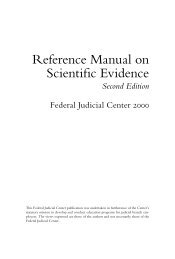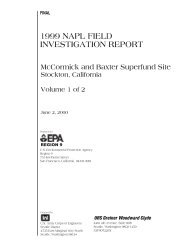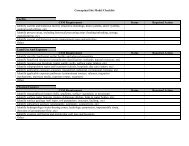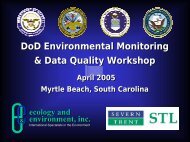Source Zone Delineation Demonstration Report - Triad Resource ...
Source Zone Delineation Demonstration Report - Triad Resource ...
Source Zone Delineation Demonstration Report - Triad Resource ...
Create successful ePaper yourself
Turn your PDF publications into a flip-book with our unique Google optimized e-Paper software.
streamtubes can result in the mixing of contaminated streamtubes with uncontaminated streamtubes.Under these conditions, concentrations of contaminants are diluted to values below those concentrationsat, or in the immediate vicinity of, a source zone. As the source zone is progressively removed from thewell, the well sees a smaller and smaller source as the angle subtended by the contaminated streamtubebecomes smaller. Thus, the amount of streamtube dilution increases with the distance of the source zonefrom the extraction well. For soil vapor extraction, operating conditions significantly influence the zoneof influence of the treatment system, and subsequently, the amount of streamtube dilution experienced bythe flow field. The effects of streamtube dilution are compounded as the flow regime transitions fromlow-flow to high-flow conditions where mass transfer limitations become increasingly important and canlimit the rate of mass removal thereby, reducing the TCE concentration in the extracted vapor.The position of the screened intervals of the vapor extraction wells in relation to the modeled vadose zonesoil architecture is shown in Figure 5-37. The screened interval of each well is shown in red on a west-toeastvertical cross section through the model at a northing corresponding to the northing of the well. Theinferred soil types immediately adjacent to the screened interval of each well are summarized in Table 5-6. The spatial continuity of soil types between extraction wells, partially apparent on Figure 5-37, isillustrated in Figure 5-38, which shows a series of eight horizontal slices at five-foot increments throughthe soil architecture. The elevation of the slices shown in Figure 5-38 includes the screened interval of allsix of the vapor extraction wells and ranges from 4,560 to 4,525 feet amsl. A red circle surrounding ablue dot indicates that a well is screened at the indicated elevation, whereas a solid blue dot indicates thata well is not screened at that elevation.The modeling of TCE contamination in the soil illustrated that the highest levels of soil contamination arelocated at an elevation approximately between 4,555 and 4,560 feet amsl, and at an easting between1,856,090 and 1,856,110 feet and a northing between 298,250 and 298,280 feet. The top of the screenedinterval of U12-VP1 is located within this region while the top of the screened interval of U12-VP2 islocated on its outer perimeter. In addition, the upper nine feet of the screened interval in both wells arelocated in an extensive silty-sand region, similar to the highest soil contamination. The middle six feet ofTable 5-6. Percentage of Soil Type in Screened Interval of Vapor Extraction WellsBoringScreenedPercentage of Soil Type in Screened Interval 1Interval Length(ft) Sand Silty-Sand Sandy-Silt SiltU12-VP1 20.0 0 70 30 0U12-VP2 20.0 0 70 30 0U12-VP3 20.0 0 5 95 0U12-VP4 19.4 0 45 55 0U12-VP5 19.1 0 0 80 20U12-VP6 14.9 0 30 45 25U12-VP7 15.3 25 60 15 01 Rounded to nearest 5 percentMarch 2003 5-52 OU 12 <strong>Demonstration</strong> <strong>Report</strong>Final










